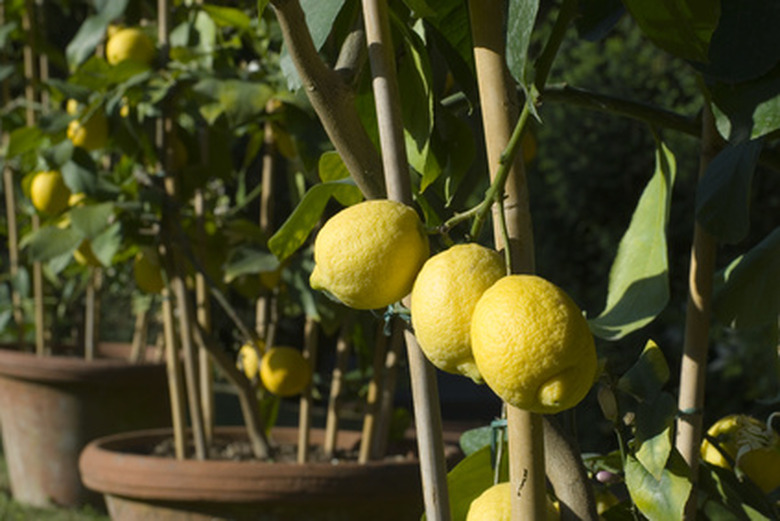How To Grow Citrus Trees In The Midwest
Things Needed
- Potting container
- Fine sand
- Peat moss
- Organic compost
- Water
- Fertilizer
- Pruning shears
The short summer months and harsh, cold winters of the Midwest can prove to be a challenge for citrus trees. Citrus trees require lots of sunlight and ample amounts of winter chilling hours to produce their fruit. Most of these cold-tender trees, however, cannot withstand temperatures below 30 degrees F without suffering permanent injury. Although the naturally grown citrus tree may fail in the Midwest, the container-grown citrus tree, or citrus bonsai, can thrive successfully in the Midwest while producing quality, edible fruit.
Step 1
Select a deep, well-drained potting container for your citrus tree. Choose a large container that can accommodate your full-size citrus tree, such as a 15-gallon pot for a 5-foot tree or Versailles container for a citrus tree up to 10-feet tall (Bonsai Gardener). Make sure you choose a container that can be easily moved from one location to the next.
- The short summer months and harsh, cold winters of the Midwest can prove to be a challenge for citrus trees.
- Although the naturally grown citrus tree may fail in the Midwest, the container-grown citrus tree, or citrus bonsai, can thrive successfully in the Midwest while producing quality, edible fruit.
Step 2
Incorporate equal amounts of clean, fine sand, peat moss and organic compost. Line the bottom of your selected container with a fine layer of mesh to prevent the soil and roots from exiting the pot. Fill the container halfway with your soil mixture and center your citrus tree in the container. Fill the container with soil so the final surface is approximately 3 inches from the rim, as explained by the Texas A&M AgriLife Extension.
Step 3
Water your newly planted citrus plant thoroughly until the water flows evenly from the drainage system. Place your citrus in a warm, sunny location that receives at least eight hours of full, direct sunlight each day. Keep the citrus bonsai away from areas with direct temperature variations, such as drafty doorways, patio decks and heating vents.
- Incorporate equal amounts of clean, fine sand, peat moss and organic compost.
- Line the bottom of your selected container with a fine layer of mesh to prevent the soil and roots from exiting the pot.
Step 4
Irrigate your citrus tree deeply about once each week. Check the soil levels prior to watering to avoid over-watering. Place your finger about 1 to 2 inches deep into the soil. Irrigate the citrus tree when the soil feels slightly dry, but never allow the tree to dry out completely. Water the tree evenly and allow the excess to flow from the drainage system. Adjust the irrigation levels during periods of drought and rainfall, and always reduce the irrigation levels during the dormancy period.
Step 5
Feed your potted citrus tree in the early spring, just before bud break. Select a well-balanced, water-soluble fertilizer such as a 10-10-10 or 8-8-8 combination. Apply the fertilizer at half strength to prevent root burn, as recommended by Guide to Houseplants.com.
- Irrigate your citrus tree deeply about once each week.
- Check the soil levels prior to watering to avoid over-watering.
Step 6
Prune your citrus tree to promote healthy growth and to develop shape. Complete the pruning process during the citrus tree's dormancy period. Remove leggy growth, as well as dead, dying or wilting foliage, branches and stems. Use sharp, sterile pruning shears.
Step 7
Allow your container-grown citrus tree to grow outdoors during the warm spring, summer and fall months. Begin acclimating your citrus to the indoor environment as the temperatures near 50 degrees F. Reduce your tree's sunlight over the course of a four-week period before bringing the tree indoors, as recommended by the Texas A&M AgriLife Extension.
